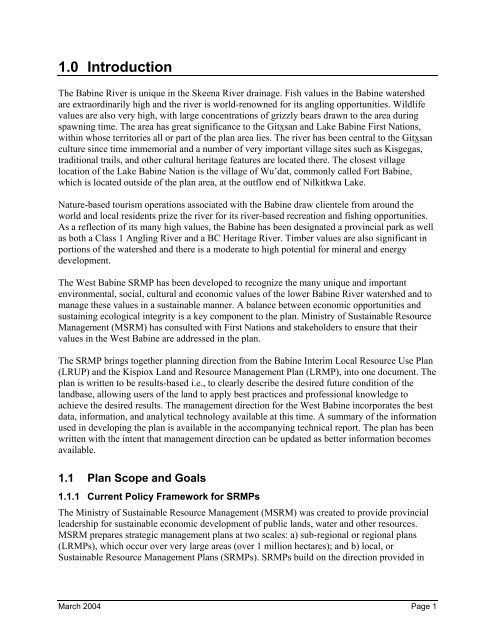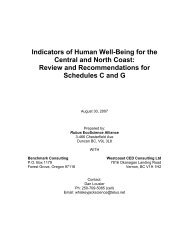West Babine Sustainable Resource Management Plan
West Babine Sustainable Resource Management Plan
West Babine Sustainable Resource Management Plan
You also want an ePaper? Increase the reach of your titles
YUMPU automatically turns print PDFs into web optimized ePapers that Google loves.
1.0 Introduction<br />
The <strong>Babine</strong> River is unique in the Skeena River drainage. Fish values in the <strong>Babine</strong> watershed<br />
are extraordinarily high and the river is world-renowned for its angling opportunities. Wildlife<br />
values are also very high, with large concentrations of grizzly bears drawn to the area during<br />
spawning time. The area has great significance to the Gitxsan and Lake <strong>Babine</strong> First Nations,<br />
within whose territories all or part of the plan area lies. The river has been central to the Gitxsan<br />
culture since time immemorial and a number of very important village sites such as Kisgegas,<br />
traditional trails, and other cultural heritage features are located there. The closest village<br />
location of the Lake <strong>Babine</strong> Nation is the village of Wu’dat, commonly called Fort <strong>Babine</strong>,<br />
which is located outside of the plan area, at the outflow end of Nilkitkwa Lake.<br />
Nature-based tourism operations associated with the <strong>Babine</strong> draw clientele from around the<br />
world and local residents prize the river for its river-based recreation and fishing opportunities.<br />
As a reflection of its many high values, the <strong>Babine</strong> has been designated a provincial park as well<br />
as both a Class 1 Angling River and a BC Heritage River. Timber values are also significant in<br />
portions of the watershed and there is a moderate to high potential for mineral and energy<br />
development.<br />
The <strong>West</strong> <strong>Babine</strong> SRMP has been developed to recognize the many unique and important<br />
environmental, social, cultural and economic values of the lower <strong>Babine</strong> River watershed and to<br />
manage these values in a sustainable manner. A balance between economic opportunities and<br />
sustaining ecological integrity is a key component to the plan. Ministry of <strong>Sustainable</strong> <strong>Resource</strong><br />
<strong>Management</strong> (MSRM) has consulted with First Nations and stakeholders to ensure that their<br />
values in the <strong>West</strong> <strong>Babine</strong> are addressed in the plan.<br />
The SRMP brings together planning direction from the <strong>Babine</strong> Interim Local <strong>Resource</strong> Use <strong>Plan</strong><br />
(LRUP) and the Kispiox Land and <strong>Resource</strong> <strong>Management</strong> <strong>Plan</strong> (LRMP), into one document. The<br />
plan is written to be results-based i.e., to clearly describe the desired future condition of the<br />
landbase, allowing users of the land to apply best practices and professional knowledge to<br />
achieve the desired results. The management direction for the <strong>West</strong> <strong>Babine</strong> incorporates the best<br />
data, information, and analytical technology available at this time. A summary of the information<br />
used in developing the plan is available in the accompanying technical report. The plan has been<br />
written with the intent that management direction can be updated as better information becomes<br />
available.<br />
1.1 <strong>Plan</strong> Scope and Goals<br />
1.1.1 Current Policy Framework for SRMPs<br />
The Ministry of <strong>Sustainable</strong> <strong>Resource</strong> <strong>Management</strong> (MSRM) was created to provide provincial<br />
leadership for sustainable economic development of public lands, water and other resources.<br />
MSRM prepares strategic management plans at two scales: a) sub-regional or regional plans<br />
(LRMPs), which occur over very large areas (over 1 million hectares); and b) local, or<br />
<strong>Sustainable</strong> <strong>Resource</strong> <strong>Management</strong> <strong>Plan</strong>s (SRMPs). SRMPs build on the direction provided in<br />
March 2004 Page 1

















